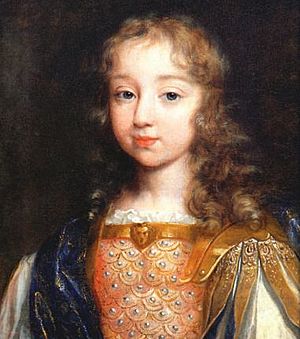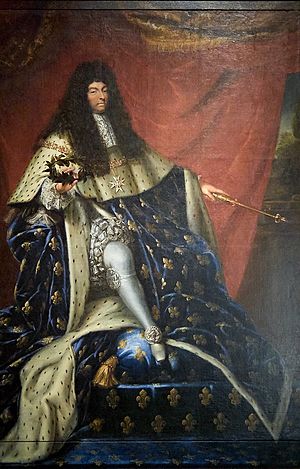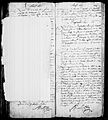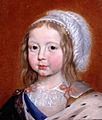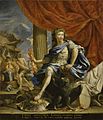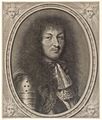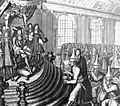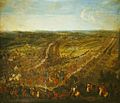Louis XIV of France facts for kids
Quick facts for kids Louis XIV |
|||||
|---|---|---|---|---|---|
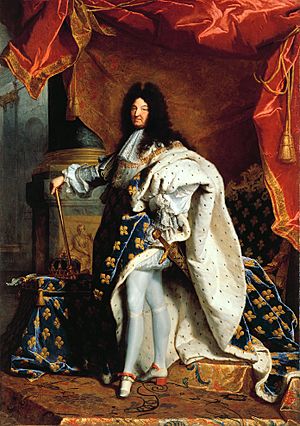
Louis XIV by Rigaud (1701)
|
|||||
| King of France and Navarre | |||||
| Reign | 14 May 1643 – 1 September 1715 | ||||
| Coronation | 7 June 1654 | ||||
| Predecessor | Louis XIII | ||||
| Successor | Louis XV | ||||
| Regent | Anne of Austria (1643–1651) | ||||
| Born | 5 September 1638 Château de Saint-Germain-en-Laye, Saint-Germain-en-Laye, France |
||||
| Died | 1 September 1715 (aged 76) Palace of Versailles, Versailles, France |
||||
| Burial | Royal Basilica, Saint-Denis, France | ||||
| Spouse | Maria Theresa of Austria Françoise d'Aubigné |
||||
| Issue | Louis, Grand Dauphin Marie Anne, Princess of Conti Louis, Count of Vermandois Louis Auguste, Duke of Maine Louise Françoise, Duchess of Bourbon Louis Alexandre, Count of Toulouse Françoise Marie, Duchess of Orléans Louise de Maisonblanche |
||||
|
|||||
| House | House of Bourbon | ||||
| Father | Louis XIII of France | ||||
| Mother | Anne of Austria | ||||
| Religion | Roman Catholicism | ||||
| Signature |  |
||||
Louis XIV, also known as the Sun King, was born on September 5, 1638. He became the King of France and King of Navarre on May 14, 1643, and ruled until his death on September 1, 1715. He was king for 72 years, which is the longest rule of any European monarch ever recorded!
Louis XIV is often seen as the best example of an absolute monarch. This means he believed his power came directly from God. He was the older of two brothers; his younger brother was Philippe, who later became the Duke of Orléans. The two brothers were very close.
Contents
Early Life and Becoming King
Louis' parents were King Louis XIII and Anne of Austria. His birth was a surprise because his parents had been married for 22 years without having children. Because of this, he was named Louis Dieudonné, which means "gift of God."
In 1643, just before his fifth birthday, his father died. This meant young Louis became the King of France. Since he was too young to rule by himself, his mother, Anne of Austria, ruled France with the help of Cardinal Mazarin. Cardinal Mazarin was a smart Italian leader who had helped France during the last parts of the Thirty Years' War. This war was a big fight for power in Europe against the Habsburg family, who ruled Spain.
Ruling as an Absolute Monarch
After Cardinal Mazarin died in 1661, Louis XIV decided to rule France all by himself. No French king had done this in a very long time! He wanted to be an absolute monarch. He truly believed that his power as king came from God, and he was only answerable to God. He felt it was his duty to rule for the good of his people.
Even though Louis made the final decisions, he often talked with his nobles and ministers. He even had weekly meetings with his main advisors. He set up a special group of advisors, which was eventually led by Jean-Baptiste Colbert, who was in charge of money.
Louis XIV was very good at showing off the power of the king. He chose the sun as his special symbol, connecting himself to its bright and powerful image. This is why he is known as the Sun King!
Building the Palace of Versailles
Starting in 1661, King Louis XIV began to change a small hunting lodge into a huge, sparkling palace. This was the famous Palace of Versailles. More than 30,000 men worked on building it, and the project cost a huge amount of money for many years.
The costs included not just building the palace, but also changing the path of rivers, bringing in fresh water, and planting thousands of orange trees. In May 1682, Louis moved the capital of France from Paris to Versailles, which was about 12 miles away. Louis XIV wanted to move himself and his nobles away from the busy and sometimes tricky politics of Paris. Versailles became a strong symbol of his absolute power.
Expanding France's Power in Europe
Louis XIV wanted his family to inherit the Spanish throne, but his main military goal was not just to grab more land. He fought his early wars to protect France's borders, especially in the north, and to push the Spanish out of important towns.
He fought the War of the Devolution (1667-1668) because he claimed parts of Spain's lands. This was after his wife's father, Philip IV, died. Louis said he should get the Spanish Netherlands because Philip IV had never paid a wedding gift he promised.
France's actions in the Spanish Netherlands made things tense with Holland. The Dutch had fought Spain for many years to protect their country. They didn't want France to become a new threat by taking over lands near their border. This led to a war in the Netherlands from 1672 to 1678. Louis showed how strong the French army was. He almost took over Holland. To stop him, the Dutch opened their dikes, flooding the land and turning Amsterdam into an island. Louis's armies couldn't go any further, and they started talking about peace.
The war started again when Spain and Austria joined Holland. Louis signed a deal with England in 1670 to keep the English navy out of the fight. Neither side could win completely, and everyone ran out of money. This finally led to a treaty to end the war.
Later Years of His Rule
One big change Louis made was ending the Treaty of Nantes. This treaty had given people in France the freedom to practice their own religion. When Louis ended it, he said that everyone in France had to be Catholic. Because of this, about 50,000 Protestant workers left France. They went to places like America, England, and Germany.
During Louis's rule, France became the most powerful country in Europe. Many other countries started to copy French fashion and ideas. He also encouraged people to explore Canada and tried hard to make France even bigger. However, Louis spent a lot of money on wars, which caused France to go into deep debt.
Decline and Legacy
By the mid-1680s, the Sun King's power started to dim a bit. Louis had always worked very hard, keeping a tough schedule his whole life. He often ignored his doctors' advice. Eventually, a broken arm stopped him from riding horses, and a foot problem (gout) ended his long walks around Versailles. He had to be wheeled or carried around.
In 1683, his first wife died. Louis then secretly married his longtime partner, Françoise d’Aubigné, Marquise de Maintenon. He also faced sadness when his oldest son died in 1711, and his oldest grandson died the next year.
After Louis XIV died, French kings had to tax the poor people a lot to try and pay off the huge debt. This was one of the reasons that later led to the French Revolution.
In his time, Louis XIV was seen as a great king because he made France very powerful and wealthy. He turned France into the strongest nation in Europe, made its borders bigger, and made sure his family would stay in power. He reached the peak of his power in the 1670s and managed to keep what he had gained for the next forty years, even when other European countries teamed up against him. He also achieved his dream of having a member of his family (a Bourbon) on the Spanish throne.
During his reign, France also became a world power by taking control of its colonies and trade. At home, Louis made the central government stronger, bringing different parts of France together into one united country. However, he also caused problems when he made everyone Catholic again by ending the Edict of Nantes and stopping Protestantism. Many of Louis's decisions, both in France and with other countries, caused great hardship for ordinary people. Many suffered from hunger, had to leave their homes, or lived in fear of being punished for their beliefs.
In the end, Louis XIV wanted to bring glory to France and his family, and he died believing that he had succeeded.
Related Pages
Images for kids
-
Europe after the Peace of Westphalia in 1648
-
1655 portrait of Louis, the Victor of the Fronde, portrayed as the god Jupiter
-
Louis and his family portrayed as Roman gods in a 1670 painting by Jean Nocret. L to R: Louis' aunt, Henriette-Marie; his brother, Philippe, duc d'Orléans; the Duke's daughter, Marie Louise d'Orléans, and wife, Henriette-Anne Stuart; the Queen-mother, Anne of Austria; three daughters of Gaston d'Orléans; Louis XIV; the Dauphin Louis; Queen Marie-Thérèse; la Grande Mademoiselle.
-
Louis XIV in 1670, engraved portrait by Robert Nanteuil
-
Louis XIV crosses the Lower Rhine at Lobith on 12 June 1672; Rijksmuseum Amsterdam
-
Siamese embassy of King Narai to Louis XIV in 1686, led by Kosa Pan. Engraving by Nicolas Larmessin.
-
Louis receiving the Doge of Genoa at Versailles on 15 May 1685, following the Bombardment of Genoa. (Reparation faite à Louis XIV par le Doge de Gênes. 15 mai 1685 by Claude Guy Halle, Versailles.)
-
Protestant peasants rebelled against the officially sanctioned dragonnades (conversions enforced by dragoons, labeled "missionaries in boots") that followed the Edict of Fontainebleau.
-
Battle of Fleurus, 1690
-
Louis XIV at the Siege of Namur (1692)
-
The Franco-Spanish army led by the Duke of Berwick defeated decisively the Alliance forces of Portugal, England, and the Dutch Republic at the Battle of Almansa.
-
The Battle of Ramillies between the French and the English, 23 May 1706
-
Bust of Louis XIV by Gianlorenzo Bernini
-
Bronze bust of Louis XIV. Circa 1660, by an unknown artist. From Paris, France. The Victoria and Albert Museum, London.
See also
 In Spanish: Luis XIV de Francia para niños
In Spanish: Luis XIV de Francia para niños


